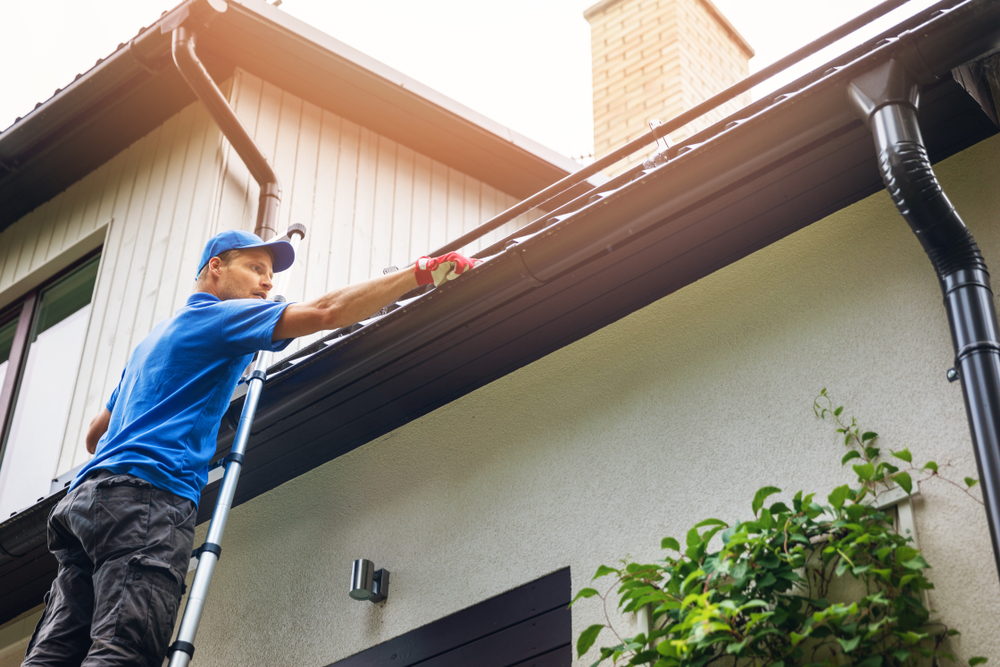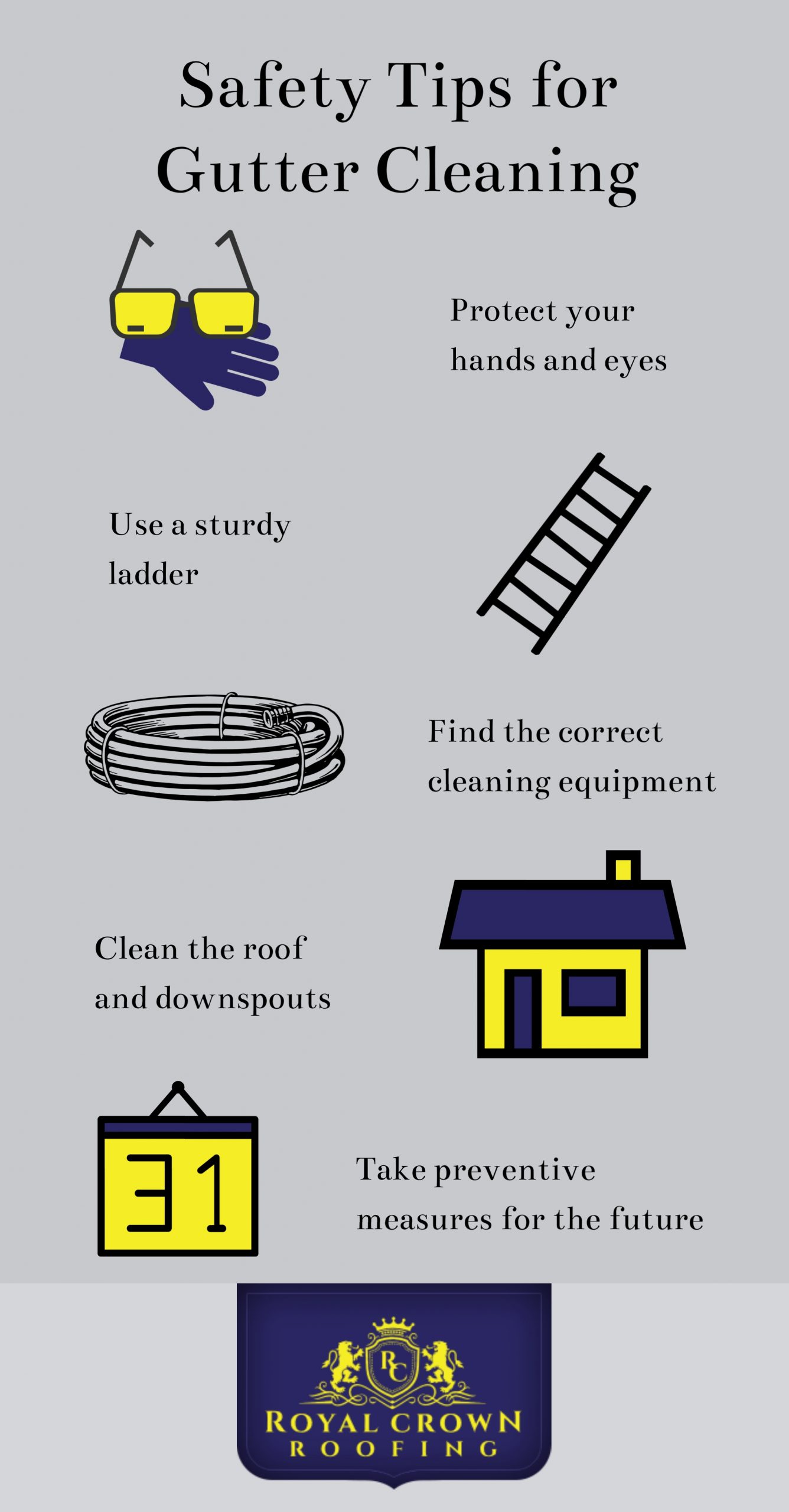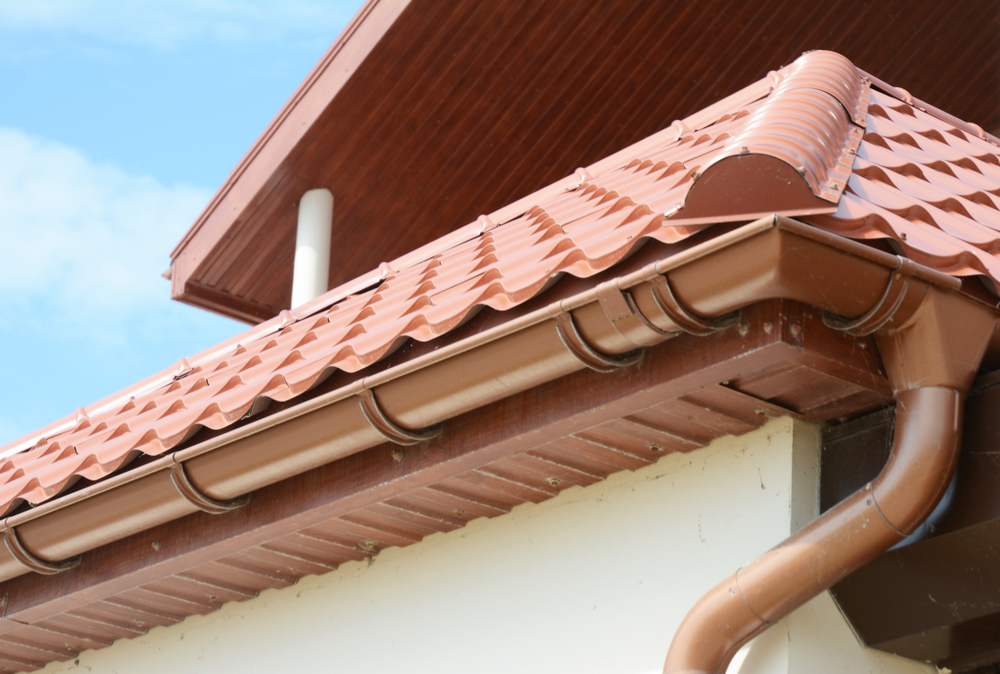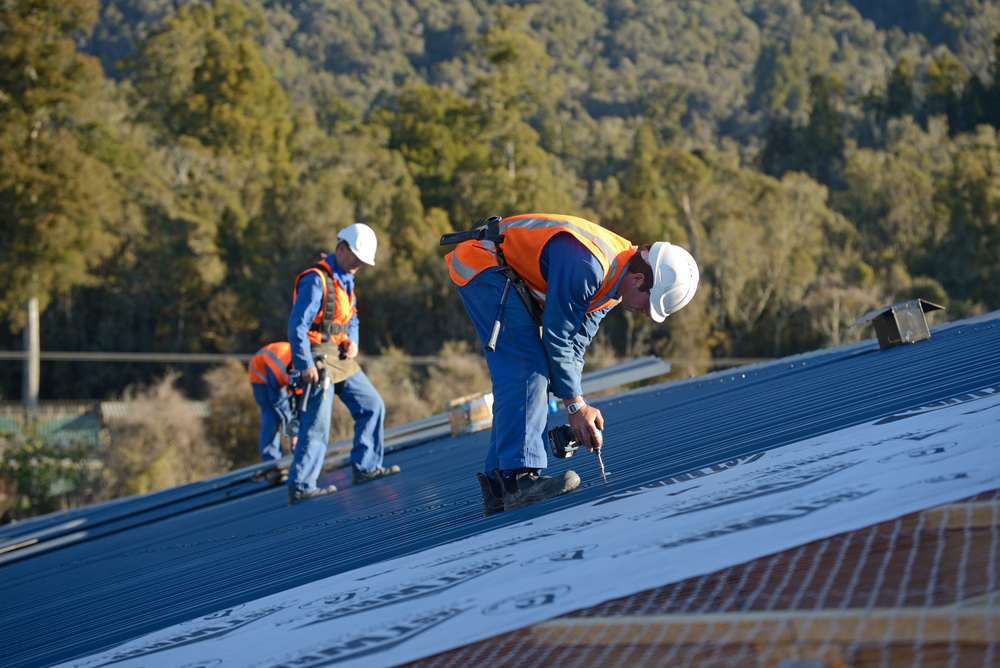
by siteadmin | Mar 27, 2020 | Gutters, Roof Cleaning, Roof Maintenance
Gutters are an important addition to your house, protecting your roof and landscaping alike from excess water damage. But as any homeowner knows, clogged gutters do no one any good and are truly a pain to clean. Letting them fill up with leaves and debris prevents free water flow, but trying to remove those leaves is a chore. How can you handle it?
Cleaning Gutters & Downspouts Safely in Spring, Texas
The most obvious concern when cleaning gutters is safety. After that, you’re probably wondering how to scoop out all the debris and what supplies you’ll need. Here are several important factors to consider as you prepare to clean out your gutter system:
- Protect your hands and eyes
- Use a sturdy ladder
- Find the correct equipment
- Clean the roof and downspouts
- Take preventive measures

1) Protect Your Hands & Eyes
Simply put, you have no idea what’s hiding in those dirty gutters. Homeowners have experienced rats, bees, and more hiding under organic debris. And even if you escape having critters hiding in your gutters, who wants to scoop out dead leaves and stagnant water with their bare hands? Play it safe and protect yourself from whatever might be in those gutters.
2) Use a Sturdy Ladder
This should go without saying. A strong, sturdy ladder, ideally with a friend holding it at the bottom, is essential to a safe cleaning job. Use a new ladder and find a strong place on the ground to balance it while you work. And if possible, use a metal ladder rather than a wooden one. Wooden ladders tend to be less stable than their metal counterparts.
3) Find the Correct Equipment
Use a gutter scoop to remove debris, rather than scooping out the blockage with your hands. This streamlines the process and makes things more pleasant for you. Once you’ve removed the worst of the debris, use a trigger spray attachment on your garden hose to remove any remaining pieces and clean the gutters more thoroughly.
4) Clean the Roof & Downspouts
Freshly cleaned gutters won’t do much good if the downspouts are clogged too or the roof is covered in leaves that the next rainstorm will wash down. Spray down the roof and flush your downspouts with the hose to remove any and all potential blockage. This will ensure that rainwater cannot pile up on your roof again.
Pro Tip: Don’t walk on the roof during a gutter cleaning session! The roof will be slick from the garden hose and dangerous to walk on. Stay on the ladder while you work.
5) Take Preventive Measures
Finally, don’t let your gutters get too clogged up. Plan on cleaning your rain gutters at least twice a year, more often if you live in an area prone to falling leaves. A few minutes of work could save you a lot of trouble later on.
Keeping Your Spring, TX. Roof in Good Shape
Cleaning gutters is no one’s favorite chore and must be done with care. However, the payoff of a clean, solid roof is absolutely worth it. Make sure to check your gutters periodically and clean them clear to prevent costly damage later on.
Connect with us to schedule your free roof inspection today!

by siteadmin | Mar 20, 2020 | Gutters, Homeowner Questions, Roof Maintenance
What comes to mind when you think of a roofing project? Like most homeowners, you’re probably thinking about materials, colors, energy efficiency, and weather resistance. All of these are important parts of redoing your roof. However, you might have forgotten a piece of equipment that helps ensure your new roof will last a long time: gutters.
Gutters may seem a bit cumbersome at times as they fill up with leaves, attract birds that leave empty nests behind, or break and pull away from the roof’s edge. You may have even encountered roofing contractors who advised against having gutters installed. However, properly installed gutters can go a long way toward ensuring that your new roof lasts. Here is a closer look at gutters and whether or not your new roof needs them.
Advantages
Gutters primarily keep rainwater from bogging down your roof and damaging its foundation. With their specially designed slopes, they divert water runoff into a spout or to a safe place on the ground, keeping your roof clear of standing water.
This function also helps the ground around your home. When water flows freely off the roof, it can gradually erode the soil around your home and damage your plants or even compromise your home’s foundation over the years. Gutters divert the water where it can’t do that kind of damage.
Disadvantages
In some climates, gutters may not be necessary. For instance, in regions with very low annual rainfall, there isn’t enough water for gutters to be worth it. Houston definitely does not fit this description, however. Houston-area homes will rely heavily on gutters to divert rainwater throughout the year.
Of course, any homeowner knows about the work that gutters can require. From chasing away pests nesting in them to cleaning out leaves that clog them up, there’s always plenty to do to keep your gutters clean and working. This time commitment can be frustrating, but to keep your gutters doing their job, it’s important.
Pro Tip: Improperly installed gutters may splash the edges of your roof, promoting stains or even mold. Only trust an expert to install your gutters and keep your home in good shape.
Keep Your Gutters in Good Shape
Every now and then, take the time to clear out your gutters of any accumulated debris. This will allow water to flow freely in the next rainstorm and protect your roof from damage.
Better yet, reduce maintenance even further by having gutter guards installed to block debris while still allowing water to flow. While this metal mesh covering isn’t perfect, it’s definitely superior to open gutters. Talk to your roofing contractor about your gutter guard options.
Give Your Roof a Long Life
Gutters are more than just a cosmetic addition to your roof. The help they provide in keeping rainwater from ruining your home’s structure is invaluable. With expert installation and proper maintenance, your new gutters will be more than worth it.
Connect with us for more information on home improvement and roofing.

by siteadmin | Mar 13, 2020 | Commercial, Roofing Materials
Have you ever wondered if there was a difference between a residential and a commercial roofing system? From the ground, most roofs may look the same, and objectively, both serve the same purpose. The type of roofing materials and installation processes between commercial and residential roofs, however, are actually quite different.
While residential roofs pertain to homes, commercial roofs vary from retail shopping centers, office buildings, and restaurants. While long term durability and quality installation is necessary for any roof, the needs of residential buildings and commercial buildings sometimes vary. Understanding these differences will help you determine the best roofing system for your project.
Type of Roofing Systems
Due to the different features installed directly on the roof, commercial roofs typically use different roofing materials than those used residentially. Even if a home has a chimney or air vent, asphalt shingles are a popular choice and can be easily installed on a home. Commercial roofs, however, may have to work around exterior structural components such as HVAC system, skylight, or external piping. In order to withstand the weather elements and secure long term durability, commercial roofs may choose polyurethane foam, built-up, concrete, or other flat roof materials.
Roofing Installation Differences
In terms of time and process, the installation of commercial and residential roofs differs. Most homes can have a roof installed within a couple of days, but a typical commercial roof may require over a month for completion. Factors such as the size of the building, roofing materials, and building codes may extend the project timeline significantly.
Pro Tip: Roofing requirements of commercial buildings can vary depending on your location, scope of business, and roofing material. Be sure to get approval for your new roof before installation.
Roof Maintenance Needs
Caring for a commercial roof is vastly different from a residential roof. Residential roofs may suffer from leaks or missing shingles, but most repairs can be easily patched. Comparatively, commercial roofs require ongoing maintenance of structural components and equipment supports in addition to normal roof maintenance. Many building owners may hire a specific person or roofing service to care for the roof entirely, especially to guard against extensive repairs that could affect working hours.
Residential & Commercial Roofing in Spring, TX
At the end of the day, commercial roofs are not the same as residential roofs. Between the different roof materials and installation required, a commercial building tends to have features that the roof of your home doesn’t contain. In order to adhere to the building codes of Spring, TX and surrounding areas, it’s important to have a roofing contractor with experience. We’re proud to have a roofing team with over 50 years of combined experience in the roofing industry.
Do you need a commercial roof installed? Connect with us on social media to learn more about commercial building practices.

by siteadmin | Mar 6, 2020 | Homeowner Questions, Roof Inspection, Roof Maintenance
Are you in the process of getting your roof repaired? Do words like “gable” or “truss” sound like a foreign language? Understanding roofing terms and how they work together in your roof system will help you make sense of the repair estimates given by roofing contractors.
Defining Important Parts of a Roof
Being able to identify the different parts of a car is comparable to your roof. If you’re unsure of how the crankshaft relates to the engine, a car diagnosis could be confusing. The same is true for the roof of your home. Becoming familiar with common roofing terms listed on estimates or inspections will help you take better care of your roof.
- Decking
- Drip Edge
- Flashing
- Gable
- Ridge Vent
- Saddle
- Shingles
- Truss
- Underlayment
- Valley
- Vent Pipe
1) Decking
The roof deck is the layer of roofing material between the frame of your roof and the outer roof shingles or coating. Besides the trusses and joints that make up the roof frame, your decking is the primary foundation of your roof. Types of deck material include steel, concrete, cement, and wood.
2) Drip Edge
Drip edges are metal sheets, usually shaped like an “L”, that are placed at the edge of your roof. Contractors install these metal sheets to direct water away from the fascia (roof edge) and into the gutter system. Older homes may not drip edges installed, but it is now required for all new homes to include drip edges in their roof systems.
3) Flashing
Flashing is the term used to define materials that are placed in specific areas on your roof to protect against leaks. Usually made of rust-resistant metal, flashing is the best way to weatherproof your home. Similar terms may include base flashing, counter flashing, step flashing, or valley flashing. Each relates to the spot on the roof where the metal strip will be installed.
4) Gable
A gable roof is the most common roof shape when thinking about roof types. The gable is the triangular portion of your roof where the edges of roof sections intersect. Similarly, a gable wall or gable end refers to the gable and wall directly underneath.
5) Ridge Vent
Compared to turbines, ridge vents are the preferred method for allowing hot, humid air out of your attic. A ridge vent is installed along the top of each roof peak and acts as a screen for interior air flow. While allowing hot air to escape from the attic, it keeps outside elements from leaking in.
6) Saddle
A cricket or saddle on your roof primarily concerns the installation of chimneys. To divert water running down the chimney to your roofing material, a ridge structure (saddle) is installed around the high side of the chimney.
7) Shingles
Usually thought of as the most popular roofing material, shingles compose the outer layer of your roof. Otherwise known as asphalt or fiberglass shingles, each home’s shingles range in color, material, and shape. Roofing contractors nail each shingle together in an interlacing pattern to ensure long term durability for your home.
Pro Tip: There are numerous shingle types to choose from your home. Be sure to coordinate the appropriate roofing material with your home’s exterior design.
8) Truss
The truss of your roof is your roof frame. Usually built away from the building site, a roof truss consists of three interlocking parts: rafters, joists, and jacks. In today’s new homes, you can find a number of different roof truss styles such as dual pitch, inverted, flat, and hip roofs.
9) Underlayment
The underlayment of your roof is a waterproof barrier placed between your roof deck and shingle material. Although shingles are your first defense against water damage, underlayment provides extra protection in case of missing shingles. A roofing underlayment can be found in there different materials including asphalt-saturated felt, synthetic, and rubberized asphalt.
10) Valley
Your roof valleys refer to the parts where your sloped roof meets, usually forming a V angle where water runs off. Depending on the design of your roof, there are three different types of valleys including woven, closed, and open valleys. It’s important to inspect your roof valleys periodically to guard against unwanted water damage.
11) Vent Pipe
Did you know plumbing has a part in your roof’s design? A vent pipe is an air pipe installed on the roof of your home to allow gases and odors to escape from your plumbing lines.
Roofing Experts in Spring, TX
Every part of your roof, even the drip edge, comes together to create a protective shield over your home. Thanks to the ingenuity of roof design, you can trust that your home won’t be exposed to weather or allow moisture to leak inside. If you’re starting to notice problems with your roof, schedule a free consultation with one of our roofing professionals. Catching roof problems early on could guard against extensive damage before it’s too late.
Looking for more roofing tips and advice? Connect with our roofing experts on social media!








